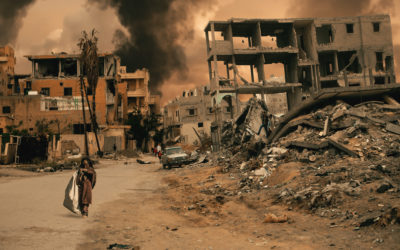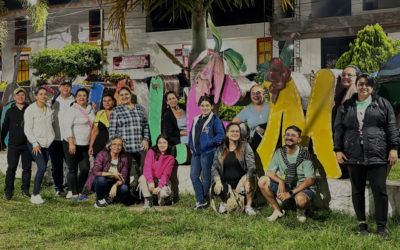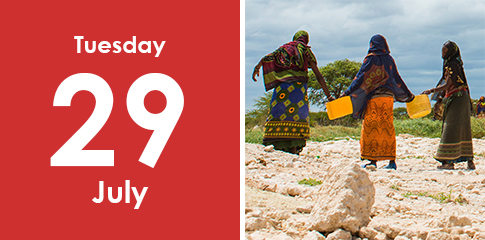A brief overview of the nexus concept
The “nexus” aims to change the traditional approach to humanitarian aid and create greater synergy with development, security, and peace. This involves creating both a strategic and operational link between humanitarian interventions and development programmes and the prevention and mitigation of security risks so that humanitarian aid, while meeting needs, also serves to invest in the Sustainable Development Goals.
This approach results from a series of discussions initiated by the United Nations and the international community in 2005 to reform humanitarian aid. They culminated in the adoption of the “nexus” at the World Humanitarian Summit held in Istanbul, Turkey, in 2016, which, combined with the associated Agenda for Humanities initiatives, advocated a New Way of Working (NwoW)1 to strengthen coherence, collaboration, mutualisation and complementarity between Humanitarian Aid and Development. This implies “capitalising on the comparative advantages of each pillar, to reduce overall vulnerability and the number of unmet needs, strengthen risk management capacities and tackle the root causes of conflict”2.
In the same vein, the two resolutions on peacekeeping adopted by the UN Security Council and General Assembly in 2016 have broadened the effort to include peace in the Triple Nexus to achieve convergence and greater autonomy for populations and communities in fragile areas while consolidating peace by reducing security risks.
1. Problem statement
Years later, the “triple nexus” operationalisation remains a thorny subject for reflection, as the expected changes within communities remain very insignificant while the threshold of vulnerability and risk factors remain high. In 2020, for example, a study carried out in Niger showed that 58% of the population in crisis zones remained dependent on aid, with 23% in extreme need (MNSA REACH, 2020)3. In Chad, the number of people in need of assistance in 2022 was estimated at 6.1 million out of a total population of 17.1 million, an increase of 17% compared to 2021, according to the Humanitarian Needs Overview (HNO Chad 2022), the country is ranked 5th most exposed to humanitarian crises and natural disasters, according to the INFORM 2022 index. Despite various humanitarian aid programmes in Cameroon, 4.4 million people urgently need assistance out of a population of more than 25 million, according to the Humanitarian Response Plan (HRP Cameroon 2021). However, this number has fallen slightly to 3.9 million by 2022.
Since 2012, humanitarian responses have struggled to achieve the population resilience they seek. Poverty is increasing in conflict zones, global security is deteriorating further, and recurring crises in various countries in the Sahel and Lake Chad Basin are becoming more violent. This raises the question of reconciling humanitarian imperatives, development actions, and peace when security crises multiply.
2. Far from the goal, but some positive initiatives to capitalise on
In the South in general and in the Sahel and Lake Chad Basin in particular, where the worsening of multidimensional crises since 2015 requires a conjunction of actions, several commitments have been made since 2016 under the leadership of States to translate into action the change in the aid mechanism aimed at by the Humanitarian-Development-Peace and Security (HDP) “triple nexus”. One of the most important is the creation of coordination bodies at the national and regional levels, in line with the orientations of the 2016 Istanbul Summit and in alignment with the Agenda for Humanity.
Thus in 2018, Niger established the Tripartite High-Level Committee on Nexus, and in 2019 and 2020, respectively, the HDP Nexus Task Forces were set up in Cameroon and Chad. The aim here is to develop the nexus approach and facilitate its operationalisation at the community level. Cameroon identified convergence zones in 2017, and Niger and Chad followed suit later, committing their governments to the process of institutionalising and operationalising nexus by identifying priority zones/convergence zones.
The World Bank largely provides financial support for implementing the nexus via the International Development Association (IDA)4, a member of the Bank Group. Financing results for the decade leading up to 2020 are as follows. Other donors, such as the European Union and USAID, are also providing substantial funding in the Sahel and Lake Chad Basin regions to support the implementation of the nexus. 21.5 million euros have been mobilised for this purpose for the 2017-2021 period in Chad as part of the DIZA programme (inclusive development programme in host areas), combining humanitarian aid with development cooperation.
3. Challenges facing the triple nexus in the South
Despite the efforts made by States, UN agencies, donors, and NGOs to align, institutionalise and operationalise the nexus, there are still significant challenges, and the desired interaction between humanitarianism, development, peace, and security does not yet seem to have been fully achieved. Here are just a few of these challenges, without being exhaustive:
Poor communication: Communication on the “triple nexus” is one of the main challenges to its operationalisation, as the discourse on the “nexus” seems to have remained structured until now and is not well assimilated. Reports from NGOs and UN agency missions in the field reveal that many stakeholders (beneficiaries, NGO managers, local authorities, elected municipal representatives, etc.) need to be more informed about the concept. Therefore, efforts in this direction are necessary if we hope to reverse the trend.
Intervention coordination: The bottlenecks include better synergy and operational complementarities between actors. There still needs to be clearer transition strategies between humanitarian responses and development actions, causing delays in implementing emergency assistance, which is not conducive to the concrete resilience of targeted communities. Clearly, the violins are not always in tune with a concerted and unified approach between organisations that remain attached to their flags5.
Choosing priority areas, political stakes, or real needs? Several NGO reports have pointed to arbitrariness in the prioritisation and planning of interventions. The areas in which development projects are implemented are not always defined in terms of humanitarian needs but often in relation to other political criteria, with operational interaction between the three pillars of the triple nexus remaining an unfulfilled objective. This reality is reflected, for example, in the mismatch between the initial orientations of IDA funding and related initiatives such as the PARCA project6, limiting the ability of crisis-affected populations to move away from dependence on humanitarian aid.
Structuring funding mechanisms: Reversing vulnerability curves is becoming increasingly difficult as humanitarian aid funding declines. From 2013 to 2020, the average Sahel and Lake Chad Basin aid funding rate was around 60%. On 31 December 2021, it stood at minus 40% (HRP 2022). Also, the volume of earmarked funds remains very high concerning overall humanitarian aid funding, leading to increased agency management costs and a lack of efficiency in responses, while the management of funds allocated to the governments by the World Bank in support of refugee host communities in areas where security crises are more acute needs to be improved.
Organisation mandates: The other major issue is organisational mandates, which remain a challenge for new humanitarianism. The “Grand Bargain”, based on the “quid pro quo” concept, requires actors to work together and accept compromises in the aid delivery process. Yet humanitarian organisations still cling to their traditional principles, which a fortiori today presents an ambiguity regarding the need to work with all actors, raising ethical dilemmas about the neutrality and independence of aid and the need to prioritise saving lives.
4. Conclusion
In light of the above, while it is true that encouraging initiatives and actions have been undertaken in the Sahel and Lake Chad Basin regions, as in other countries of the South, to operationalise the triple nexus, it is also clear that the desired synergy between the three components of humanitarian aid – development – peace and security is struggling to be effective, not only at field level but also at strategic level. There is, therefore, still a long way to go, and far-reaching reforms need to be undertaken in the funding planning system and the design and implementation of humanitarian interventions and development programmes while ensuring priorities are chosen jointly and contextually.
By Robert Petron Messe, Alumnus of the Development Policies and Practices Programme 2021-2022
1 At the 2016 Humanitarian Summit, the United Nations and the humanitarian community adopted the Global Compact for Refugees and the Compact for Forced, Orderly and Regular Migration, enshrining a New Way of Working that prioritises a more sustainable partnership and greater involvement of all actors. The Grand Bargain agreement and the report by UN Secretary-General Ban-Ki Moon, published in February 2016 ahead of the Istanbul Summit, should also be consulted in this regard.
2 OECD-DAC recommendations on Humanitarian-Development-Peace Nexus, 2019.
3 Multisectoral Need Assessments (MNSA) are assessments carried out in various humanitarian assistance sectors and jointly by several actors to establish the most urgent needs of populations in crisis.
4 Since its creation in 1960, IDA has undergone 18 ordinary replenishments to readjust its financing mechanisms and mobilise more funds, the latest being IDA-18, which covered fiscal 2018 to 2020 and mobilised $75 billion in commitments. Find out more about IDA by clicking here. Information on IDA’s financing results can also be found here.
5 See: Calhoun, C. (2010). The idea of emergency: Humanitarian action and global (dis) order. Contemporary states of emergency: The politics of military and humanitarian interventions, 29-58.
6 The Support Project for Refugees and Host Communities (PARCA) provided $274 million in 2017 to Cameroon, $80 million in 2018 to Niger and $295 million to Chad in 2022 to advance the triple nexus.









Courage a toi . félicitations